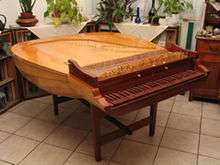Lautenwerck
The lautenwerck (also spelled lautenwerk), alternatively called lute-harpsichord (lute-clavier), is a European keyboard instrument of the Baroque period. It is similar to a harpsichord, but with gut rather than metal strings, producing a mellow tone.

Lautenwerck
The instrument was favored by J. S. Bach, who owned two of the instruments at the time of his death, but no specimens from the 18th century have survived to the present day.[1] It has been revived since the 20th century by harpsichord makers Willard Martin, Keith Hill and Steven Sorli. Two of its most prominent performers are the early music specialists Gergely Sárközy and Robert Hill.
Media
Performances by Gergely Sárközy are also freely available.[2]
Notes
- Henning, p. 477
- Including BWV 996 - Prelude-Presto and BWV 996 - Bourree, both via Archive.org
gollark: Installing potatOS within OneOS will overwrite OneOS with potatOS; installing OneOS within potatOS will be fine.
gollark: CraftOS is installed by default.
gollark: Quite well, I think.
gollark: Look, try potatOS yourself, the speed difference is small.
gollark: Well, boot time is taken up by:* checking for updates* initialising the sandbox* downloading init code* running init codebut with the fast reboot thing it only does the running init code bit.
References
- Henning, Uta (October 1982). "The Most Beautiful Among the Claviers: Rudolf Richter's Reconstruction of a Baroque Lute-Harpsichord". Early Music. 10 (4): 477–486. doi:10.1093/earlyj/10.4.477. JSTOR 3126936.
External links
| Wikimedia Commons has media related to Lautenwerck. |
- Lautenwerck page
- Information (Tihamér Romanek)
- Gallery of pictures and sounds (Stevie Sorli)
This article is issued from Wikipedia. The text is licensed under Creative Commons - Attribution - Sharealike. Additional terms may apply for the media files.
